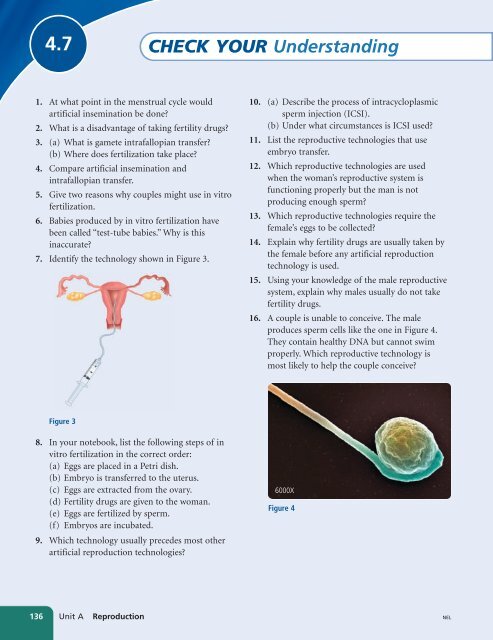Unit A Reproduction
Unit A Reproduction
Unit A Reproduction
Create successful ePaper yourself
Turn your PDF publications into a flip-book with our unique Google optimized e-Paper software.
4.7<br />
CHECK YOUR Understanding<br />
1. At what point in the menstrual cycle would<br />
artificial insemination be done?<br />
2. What is a disadvantage of taking fertility drugs?<br />
3. (a) What is gamete intrafallopian transfer?<br />
(b) Where does fertilization take place?<br />
4. Compare artificial insemination and<br />
intrafallopian transfer.<br />
5. Give two reasons why couples might use in vitro<br />
fertilization.<br />
6. Babies produced by in vitro fertilization have<br />
been called “test-tube babies.” Why is this<br />
inaccurate?<br />
7. Identify the technology shown in Figure 3.<br />
10. (a) Describe the process of intracycloplasmic<br />
sperm injection (ICSI).<br />
(b) Under what circumstances is ICSI used?<br />
11. List the reproductive technologies that use<br />
embryo transfer.<br />
12. Which reproductive technologies are used<br />
when the woman’s reproductive system is<br />
functioning properly but the man is not<br />
producing enough sperm?<br />
13. Which reproductive technologies require the<br />
female’s eggs to be collected?<br />
14. Explain why fertility drugs are usually taken by<br />
the female before any artificial reproduction<br />
technology is used.<br />
15. Using your knowledge of the male reproductive<br />
system, explain why males usually do not take<br />
fertility drugs.<br />
16. A couple is unable to conceive. The male<br />
produces sperm cells like the one in Figure 4.<br />
They contain healthy DNA but cannot swim<br />
properly. Which reproductive technology is<br />
most likely to help the couple conceive?<br />
Figure 3<br />
8. In your notebook, list the following steps of in<br />
vitro fertilization in the correct order:<br />
(a) Eggs are placed in a Petri dish.<br />
(b) Embryo is transferred to the uterus.<br />
(c) Eggs are extracted from the ovary.<br />
(d) Fertility drugs are given to the woman.<br />
(e) Eggs are fertilized by sperm.<br />
(f) Embryos are incubated.<br />
9. Which technology usually precedes most other<br />
artificial reproduction technologies?<br />
6000X<br />
Figure 4<br />
136 <strong>Unit</strong> A <strong>Reproduction</strong><br />
NEL

















